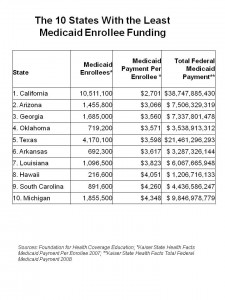![]()
![]()
![]() It will be A Day of Reckoning, 60 Minutes, the CBS News weekly program, called it. This is the impending economic collapse of U.S. state economies, caused by over-borrowing, pension accounting, lower tax revenues during the recession, expanding services, and
It will be A Day of Reckoning, 60 Minutes, the CBS News weekly program, called it. This is the impending economic collapse of U.S. state economies, caused by over-borrowing, pension accounting, lower tax revenues during the recession, expanding services, and
Next to the housing collapse of the past few years, this may be the largest threat to the American economy, according to Meredith Whitney, a Wall Street analyst quoted in the story. Chris Christie, Governor of New Jersey, says this is, “not an income problem, it’s a benefit problem.”
When we think benefits and States, we think health care — specifically, Medicaid. To virtually every state Governor in the union, health care is the #1 or #2 budget line item in his or her budget. At the same time, balancing budgets is a grueling mandate for the chiefs of States, given the states’ mounting debt (where municipal debt has expanded 90% in the past decade according to the Federal Reserve Bank), dwindling tax receipts in the recession, and growing pension burdens for retired workers, amounting to deficits of over $1 trillion. Where does health care for the poor and uninsured fit into this dire economic landscape?
Health Populi’s Hot Points: In 2014, the Patient Protection and Affordable Care Act (ACA), aka health reform, kicks in and expands Medicaid to cover uninsured Americans. The law provides for the Federal government to cover 96% of the costs of Medicaid expansion to the states.
But in the meantime, there’s 2011, 2012, and 2013 to consider when it comes to states providing health services to an expanding uninsured population under an already-stressed Medicaid program in pressure-cooker local economies. Whitney told Bloomberg Television in September 2010 that state bailouts might be called on for California, New Jersey, Illinois and Ohio.
Geography is destiny when it comes to Medicaid coverage: where you live is a predictor of how well Medicaid will cover you. The Kaiser Family Foundation‘s data identified that the 10 least-funded Medicaid plans are in California, Arizona, Georgia, Oklahoma, Texas, Arkansas, Louisiana, Hawaii, South Carolina and Michigan, all shown in the chart. The best-funded Medicaid funding occurs in Rhode Island, New York, District of Columbia, Alaska, New Jersey, Minnesota, Massachusetts, Connecticut, North Dakota and Pennsylvania.
It’s important to note that in states with low-funding of Medicaid, providers tend to shift higher charges onto patients who are covered by health plans other than Medicaid: notably, private sector-sponsored health plans provided by employers. And employers’ commitments to providing health insurance are eroding, a trend regulatory tracked in Health Populi. most recently here. The Commonwealth Fund forecasts that the annual costs of health insurance for a family of four could reach $23,342 in 2020.




 Interviewed live on BNN Bloomberg (Canada) on the market for GLP-1 drugs for weight loss and their impact on both the health care system and consumer goods and services -- notably, food, nutrition, retail health, gyms, and other sectors.
Interviewed live on BNN Bloomberg (Canada) on the market for GLP-1 drugs for weight loss and their impact on both the health care system and consumer goods and services -- notably, food, nutrition, retail health, gyms, and other sectors. Thank you, Feedspot, for
Thank you, Feedspot, for  As you may know, I have been splitting work- and living-time between the U.S. and the E.U., most recently living in and working from Brussels. In the month of September 2024, I'll be splitting time between London and other parts of the U.K., and Italy where I'll be working with clients on consumer health, self-care and home care focused on food-as-medicine, digital health, business and scenario planning for the future...
As you may know, I have been splitting work- and living-time between the U.S. and the E.U., most recently living in and working from Brussels. In the month of September 2024, I'll be splitting time between London and other parts of the U.K., and Italy where I'll be working with clients on consumer health, self-care and home care focused on food-as-medicine, digital health, business and scenario planning for the future...